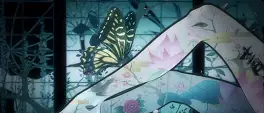Aoi Bungaku (Blue Literature)
The first story of Aoi Bungaku, No Longer Human, is covered in a soft, often wintry mist that permeates through to the character's unsurprising end. The remaining five stories however are vividly realised, varying between sharp reality and kaleidoscopic dreamscapes; each conveys the vagaries of humanity with poignancy and skill. So too changes the attitude in each story, from the purgatorial trappings of the first story to the theatrical analogy of Run, Melos! to the Rashomon-esque multiple viewpoints of Kokoro. An ambitious and vibrantly successful venture that wears its literary roots proudly, portraying characters with unflinching amorality and focusing not on full-circle stories but short vignettes of startlingly tangible people.
The first four episodes tell the story of Yozo and his attempt to come to terms with his more base instincts and emotions which more often than not lead him to psychological turmoil, not helped by his sexual reliance or penchant for escapism. The second tale is of Shigemaru, a callous thief who one day comes across the beautiful but demanding Mitsuki whose bloodthirsty attitude is tempered only by her morbid fascinations. Shigemaru battles with his fear of the forest's cherry blossom grove while capitulating to all of Mitsuki's murderous whims. The third story is of a gentleman known only as Sensei who invites a scruffy man, K, into the house where he is staying; told from two differing perspectives, both concern the daughter of the house, her affections and the results of a cross-communication between the men. The fourth narrative is of a man tasked with adapting a story for theatre but the process opens old wounds with the parallels it has with his own life. The final two stories are set within the world of a fickle and flamboyant king: the fifth sees the capture of the wicked criminal Kandata, his execution and descent into hell; the sixth follows the artist Yoshihide who, disillusioned with a kingdom he sees as rife with violence and cruelty, is ordered by the king to paint a vision of the land on the walls of his tomb.



